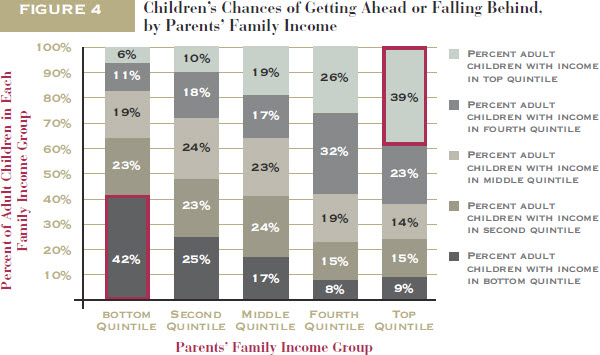Social mobility comes in two varieties: absolute and relative. Absolute mobility is a measure of whether people are better or worse off than their parents were, which means that everyone can be upwardly mobile. Relative mobility is a measure of where people are ranked on the income ladder, compared to their parents’ rank. By definition, no more than half the population can be relatively upwardly mobile. (Look at Pew’s video on the difference between relative and absolute mobility.)
I have suggested in the New York Times today that more attention be paid to the lack of relative downward mobility—the “stickiness” at the top of the income distribution. Here is a quintile transition matrix from earlier work by my colleagues Isabel Sawhill, Ron Haskins, and Julia Isaacs:

The bottom left corner tells us that 42% of the children raised in the bottom income quintile remain there as adults. They are “stuck” at the bottom of the income ladder. Just 6% make it into the top quintile. The general assumption is that something is wrong here: talented children are being held back, and down, by lack of opportunity, education, family support, and so on.
Now look at the top right corner: 39% of those raised in the top quintile as children remain there as adults. They are “stuck” at the top of the income ladder. Just 9% fall into the bottom quintile. Isn’t there something wrong here too?
There is comparatively little interest in this stickiness at the top, in part because the politics might be discomforting. I have suggested that access to college, especially to highly-selective schools, and the allocation of unpaid internships are both areas where potential opportunity hoarding might be taking place. On internships, see this piece on how White House interns are disproportionately made up of sons and daughters of the well-connected.
In just the same way that a glass ceiling may be preventing talented poor kids from rising, there may be a glass floor preventing untalented rich kids from falling. A couple of caveats:
- Right now, most of the evidence for the glass floor is indirect: we need some more research on this question.
- Even if opportunity hoarding is taking place, the lack of downward mobility is clearly nothing like as big a moral or economic problem as lack of upward mobility—indeed, it arguably only matters at all to the extent that it reduces upward mobility.
Let’s at least come clean about our goals here. Do we want more absolute mobility, more relative mobility, or more of both? I want more of both. I want more than 6% of those born in the bottom quintile to make it into the top quintile. One fact nobody can deny is that the top quintile can only contain 20% of the population: that means that more affluent kids will have to drop down the ladder.
The Brookings Institution is committed to quality, independence, and impact.
We are supported by a diverse array of funders. In line with our values and policies, each Brookings publication represents the sole views of its author(s).




Commentary
The Case for Downward Mobility
September 30, 2013